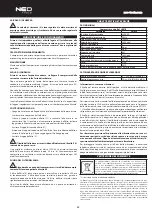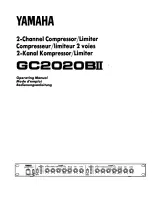
neo-tools.com
neo-tools.com
8
TRANSLATION OF ORIGINAL MANUAL
OIL LUBRICATED COMPRESSOR
12K010
CAUTION: BEFORE USING THE COMPRESSOR READ THIS MANUAL CAREFULLY
AND KEEP IT FOR FUTURE REFERENCE.
GENERAL SAFETY RULES
Observe the following safety regulations to avoid risks of electric shock,
body injury or fire.
1. Keep the work place clean and tidy.
Untidiness in the work place
increases risk of injury at work.
2. Pay attention to work place conditions.
Never leave the compressor
in rain. Do not use the compressor in damp or wet location, or close to
flammable substances (fluid, gas). Provide good work place illumination.
3. Protect yourself against electric shock.
Avoid direct contact with
grounded objects, such as pipes, radiators, ovens, refrigerators etc.
4. Protect the compressor work place against access of children and
animals.
Bystanders should stay away from operating compressor. Store
the compressor in a dry, closed place and beyond reach of children.
5. Do not overload the compressor.
The compressor should operate
within limitations of working parameters. This allows better, safer and
more efficient operation.
6. Use proper personal protection measures when working with the
compressor.
Do not wear loose jewellery or other decorative items as
there is risk of catching by moving parts of the compressor. Pin your hair
up and hide under a cap.
7. Use goggles or protective glasses.
When working in a dusty room use
protective half-mask that protects your respiratory tract.
8. Never use the power cord for purposes it is not designed for.
Do not
pull the compressor by its power supply cord. Never unplug the power
cord from mains socket by pulling the cord. Protect the power cord
against excessive temperature, oil and sharp edges.
9. Do not bend over the compressor.
Stand firmly and keep your balance
at all times.
10. Keep the compressor in good condition.
Keep the compressor clean,
this will ensure long and reliable operation. Observe instructions in the
manual. Check technical condition of power cord and plug on a regular
basis. Have it repaired by a qualified specialist if found damaged. Check
technical condition of extension cord (if used) and replace if found
damaged.
11. Disconnect the compressor from power supply.
In case the power
cord insulation is damaged or worn out, immediately disconnect the
compressor from power supply. Whenever the compressor is not in use,
disconnect it from power supply by unplugging from mains socket.
12. Do not leave objects on the compressor.
Make sure that tools and
other objects are removed before turning the compressor on.
13. Avoid accidental starting of the compressor.
Make sure the switch
button is in OFF position prior to plugging the compressor to power
supply.
14. Check the compressor against wear symptoms.
Each time you turn the
compressor on carefully check all safety items and other accessible parts
for damages and whether they can operate as designed. All stationary
parts must be well fixed to make sure the device will operate properly.
Damaged safety items and moving parts of the compressor should be
repaired or replaced in a service workshop, unless otherwise stated in
this manual. Faulty switches should be replaced by service workshop.
When the switch does not allow to switch on or off, do not attempt to
repair it.
15. Important!
For your own safety use only original parts and accessories
that are recommended by the manufacturer. Use of other parts bears
high risk of an accident.
DETAILED SAFETY REGULATIONS
Observe the following regulations for occupational health and safety.
• Do not direct air stream at people, animals or at yourself.
• Do not use compressed air to clean clothes on a person.
• Stream of liquid sprayed by devices connected to the compressor must not
be directed onto the compressor.
• Do not work barefoot or with wet hands.
• Do not move the compressor with pressurised tank.
• Do not weld or repair the tank. Replace the tank in authorised service
workshop in case of damage or corrosion.
• Do not allow inexperienced persons to operate the compressor.
• Clean the compressor with damp cloth and mild detergent only.
• The compressor is designed solely for air compression, do not use it for any
other gas.
• Compressor and its hoses reach high temperature during operation. Avoid
contact! Risk of burns!
• When disconnecting devices hold the connection part in hand to avoid
body injury resulting from reaction kick.
• Wear anti-splinter goggles at work. Foreign body particles thrown with
compressed air may cause body and eye injuries.
• Do not use paints and solvents that have ignition temperature below 210°C.
• Do not heat up paints or solvents.
• Observe safety information provided by the manufacturers of used liquids.
• When lacquer spraying, the operator and other persons in the room must
not smoke under any circumstances. Paint fumes are highly flammable.
• When spraying paint or lacquer use protection mask to prevent inhalation
of toxic substances.
• Make sure there are no open flames or sparking devices in the room where
the compressor operates.
• Do not eat or drink in the room where you work. Paint fumes are dangerous
to health.
• Use the compressor only in rooms with efficient ventilation system and in
ambient temperature within range +5°C to +40°C.
• Act reasonably and in accordance with respective regulations.
• You can use power supply extension cords only with protective wire,
maximum length 5 m and cross section equal or greater than 1.5 mm2.
USE OF PRESSURE TANKS
Pressure tank is used to hold pressurised air and should be used in static
conditions. Proper use of the tank is the basic condition for keeping it safe.
Therefore, user should observe the following instructions:
• Use the tank properly within defined temperature and pressure limitations,
provided by the manufacturer and marked on the rating plate.
• Do not carry out tank repair or maintenance works when under pressure.
• Make sure all protection and regulation devices work properly, and when
necessary obtain the manufacturer’s authorisation to replace with new
devices of the same specification.
• Safety valve should be set to working pressure of the tank and compressor,
then sealed.
• Avoid tank operation in poorly ventilated rooms whenever possible. Avoid
tank installation close to sources of heat or flammable substances.
• Do not attach the tank or parts installed with it to floor or other stationary
structures.
• Prevent corrosion: operating conditions may cause accumulation of
condensation water that must be removed.
IMPROPER USE OF THE TANK AND UNASSISTED TINKERING BY UNAU-
THORISED PERSONS IS PROHIBITED. DO NOT ADJUST THE SAFETY VALVE.
The user must follow regulations for pressure devices that are in force in the
country where the tank is used.
Never use the pressure tank when it is damaged or when exposing workers
and bystanders to danger.
In case of wall defect the pressure tank must be taken out of service.
Caution! The design is assumed to be safe, protection measures and ad-
ditional safety systems are used, nevertheless there is always a small risk
of injuries at work.









































